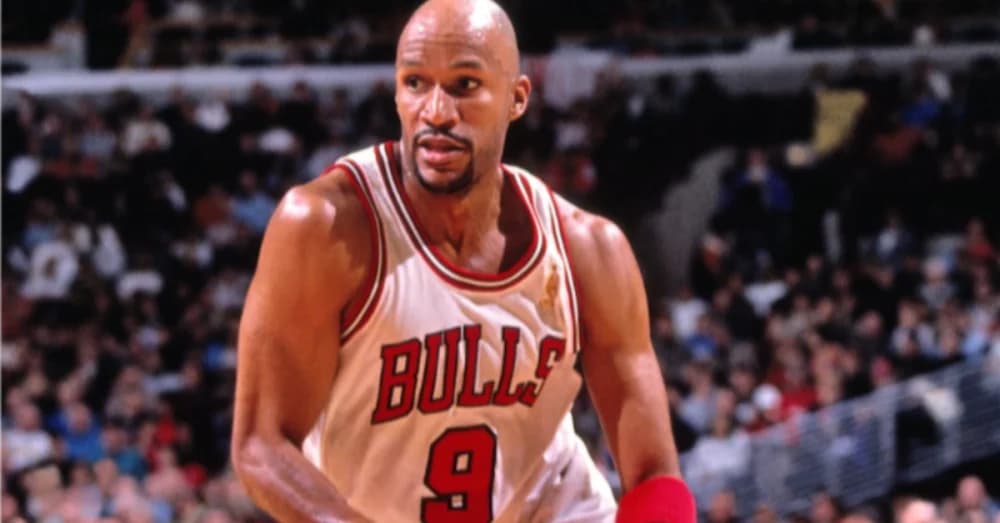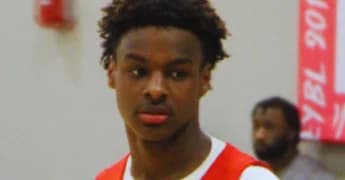
Ron Harper Claps Back at LeBron Fans: ‘Look at Rings Clown’ – The Truth About His Role with Michael Jordan’s Bulls
In the ever-persistent debate of NBA greatness, Ron Harper, a key member of the Chicago Bulls dynasty, recently found himself at the center of controversy. The five-time NBA champion, who played alongside Michael Jordan during the Bulls’ second three-peat, took to social media to address what he perceives as a mischaracterization of his career—particularly the role that Jordan played in his success.
The spark for this latest debate was an X (formerly Twitter) post by the account @HoopDon23. The post highlighted Harper’s statistical decline after joining the Bulls, suggesting that Jordan’s presence did not elevate his teammates as many MJ fans claim. Harper, known for his straightforward and no-nonsense attitude, didn’t hesitate to respond.
“Look at rings clown,” Harper fired back, succinctly pointing out that the true measure of a player’s impact and success often lies beyond mere statistics. For Harper, who won three of his five NBA titles with the Bulls, the post overlooked the critical context of his career trajectory and the unique role he played on a championship-caliber team.
Look ay rings clown 🤡
— Ron Harper (@HARPER04_5) August 19, 2024
Before his tenure with the Bulls, Ron Harper was a prolific scorer and versatile player. Between 1989 and 1994, he averaged an impressive 19.3 points, 4.8 assists, and 5.5 rebounds per game while playing for the Cleveland Cavaliers and the LA Clippers. However, his numbers saw a significant dip when he joined Chicago in 1994. During the years he played alongside Jordan from 1995 to 1998, Harper’s averages dropped to 7.5 points, 2.5 assists, and 2.8 rebounds per game.
On the surface, this decline could be interpreted as a regression or an indication that Harper’s game suffered under Jordan’s shadow. However, such an interpretation fails to consider the broader context of Harper’s role on the Bulls. His shift from a primary scorer to a defensive specialist and role player was a strategic adjustment that helped Chicago secure three consecutive championships.
Harper’s transition from a star player on struggling teams to an essential cog in a championship machine is a narrative that highlights the often-overlooked aspects of team dynamics. Before joining the Bulls, Harper had never made it past the first round of the playoffs. Despite his individual success, his teams lacked the depth and leadership needed to make deep postseason runs.
Everything changed when Harper joined the Bulls in 1994, just as Michael Jordan was returning from his 18-month hiatus. Ron Harper quickly adapted to a new role under head coach Phil Jackson, who recognized his defensive prowess and ability to contribute in ways that didn’t always show up on the stat sheet. By sacrificing personal glory for team success, Harper became an integral part of one of the most dominant teams in NBA history.
The dip in Harper’s numbers during his Bulls years is a testament to the reality of playing alongside two of the game’s greatest players—Michael Jordan and Scottie Pippen. In a system where Jordan and Pippen were the primary offensive weapons, Harper’s value came from his versatility and willingness to do the dirty work. His defensive acumen, ability to guard multiple positions, and readiness to step up in crucial moments made him a key contributor to the Bulls’ success.
Harper’s career trajectory is not an uncommon story in the NBA, where many talented players have seen their statistical output decrease when joining better teams. The narrative that Jordan’s presence somehow diminished Harper’s game ignores the reality of what it takes to win championships. Harper’s response on X, “Look at rings clown,” underscores the idea that the true measure of a player’s impact is not always reflected in the box score.
Harper’s five NBA titles—three with the Bulls and two more with the LA Lakers under Phil Jackson—serve as a testament to his adaptability and understanding of what it means to be part of a winning team. His ability to transition from a primary scorer to a championship-winning role player is a skill that often goes underappreciated in discussions about basketball greatness.
In the ongoing debate between LeBron James and Michael Jordan’s legacies, it’s crucial to remember that basketball is a team sport. Players like Ron Harper, who sacrificed individual accolades for the sake of team success, are often the unsung heroes of championship dynasties. Harper’s career is a reminder that greatness is not only measured by individual stats but also by the ability to contribute to a larger goal.
Harper’s sharp response to the ‘Bronsexuals’—a term often used to describe LeBron James’s most ardent fans—highlights the passion and intensity that surround these debates. However, it also serves as a call to look beyond numbers and appreciate the nuances of what it takes to build and sustain a championship team.
In the end, Harper’s five rings speak volumes about his career and the impact he had on the teams he played for. While statistics can provide insight into a player’s performance, they don’t always tell the full story. For Harper, and many others who have been in similar situations, the ultimate measure of success is not how many points they scored, but how many championships they won.
Ron Harper’s journey through the NBA is a powerful example of how true greatness is often found in the willingness to adapt, sacrifice, and embrace a role that leads to team success. His response to the criticism he faced serves as a reminder that in the end, championships—not individual stats—are the ultimate measure of a player’s impact on the game.
In the ever-persistent debate of NBA greatness, Ron Harper, a key member of the Chicago Bulls dynasty, recently found himself at the center of controversy. The five-time NBA champion, who played alongside Michael Jordan during the Bulls’ second three-peat, took to social media to address what he perceives as a mischaracterization of his career—particularly the role that Jordan played in his success.
The spark for this latest debate was an X (formerly Twitter) post by the account @HoopDon23. The post highlighted Harper’s statistical decline after joining the Bulls, suggesting that Jordan’s presence did not elevate his teammates as many MJ fans claim. Harper, known for his straightforward and no-nonsense attitude, didn’t hesitate to respond.
“Look at rings clown,” Harper fired back, succinctly pointing out that the true measure of a player’s impact and success often lies beyond mere statistics. For Harper, who won three of his five NBA titles with the Bulls, the post overlooked the critical context of his career trajectory and the unique role he played on a championship-caliber team.
Look ay rings clown 🤡
— Ron Harper (@HARPER04_5) August 19, 2024
Before his tenure with the Bulls, Ron Harper was a prolific scorer and versatile player. Between 1989 and 1994, he averaged an impressive 19.3 points, 4.8 assists, and 5.5 rebounds per game while playing for the Cleveland Cavaliers and the LA Clippers. However, his numbers saw a significant dip when he joined Chicago in 1994. During the years he played alongside Jordan from 1995 to 1998, Harper’s averages dropped to 7.5 points, 2.5 assists, and 2.8 rebounds per game.
On the surface, this decline could be interpreted as a regression or an indication that Harper’s game suffered under Jordan’s shadow. However, such an interpretation fails to consider the broader context of Harper’s role on the Bulls. His shift from a primary scorer to a defensive specialist and role player was a strategic adjustment that helped Chicago secure three consecutive championships.
Harper’s transition from a star player on struggling teams to an essential cog in a championship machine is a narrative that highlights the often-overlooked aspects of team dynamics. Before joining the Bulls, Harper had never made it past the first round of the playoffs. Despite his individual success, his teams lacked the depth and leadership needed to make deep postseason runs.
Everything changed when Harper joined the Bulls in 1994, just as Michael Jordan was returning from his 18-month hiatus. Ron Harper quickly adapted to a new role under head coach Phil Jackson, who recognized his defensive prowess and ability to contribute in ways that didn’t always show up on the stat sheet. By sacrificing personal glory for team success, Harper became an integral part of one of the most dominant teams in NBA history.
The dip in Harper’s numbers during his Bulls years is a testament to the reality of playing alongside two of the game’s greatest players—Michael Jordan and Scottie Pippen. In a system where Jordan and Pippen were the primary offensive weapons, Harper’s value came from his versatility and willingness to do the dirty work. His defensive acumen, ability to guard multiple positions, and readiness to step up in crucial moments made him a key contributor to the Bulls’ success.
Harper’s career trajectory is not an uncommon story in the NBA, where many talented players have seen their statistical output decrease when joining better teams. The narrative that Jordan’s presence somehow diminished Harper’s game ignores the reality of what it takes to win championships. Harper’s response on X, “Look at rings clown,” underscores the idea that the true measure of a player’s impact is not always reflected in the box score.
Harper’s five NBA titles—three with the Bulls and two more with the LA Lakers under Phil Jackson—serve as a testament to his adaptability and understanding of what it means to be part of a winning team. His ability to transition from a primary scorer to a championship-winning role player is a skill that often goes underappreciated in discussions about basketball greatness.
In the ongoing debate between LeBron James and Michael Jordan’s legacies, it’s crucial to remember that basketball is a team sport. Players like Ron Harper, who sacrificed individual accolades for the sake of team success, are often the unsung heroes of championship dynasties. Harper’s career is a reminder that greatness is not only measured by individual stats but also by the ability to contribute to a larger goal.
Harper’s sharp response to the ‘Bronsexuals’—a term often used to describe LeBron James’s most ardent fans—highlights the passion and intensity that surround these debates. However, it also serves as a call to look beyond numbers and appreciate the nuances of what it takes to build and sustain a championship team.
In the end, Harper’s five rings speak volumes about his career and the impact he had on the teams he played for. While statistics can provide insight into a player’s performance, they don’t always tell the full story. For Harper, and many others who have been in similar situations, the ultimate measure of success is not how many points they scored, but how many championships they won.
Ron Harper’s journey through the NBA is a powerful example of how true greatness is often found in the willingness to adapt, sacrifice, and embrace a role that leads to team success. His response to the criticism he faced serves as a reminder that in the end, championships—not individual stats—are the ultimate measure of a player’s impact on the game.






